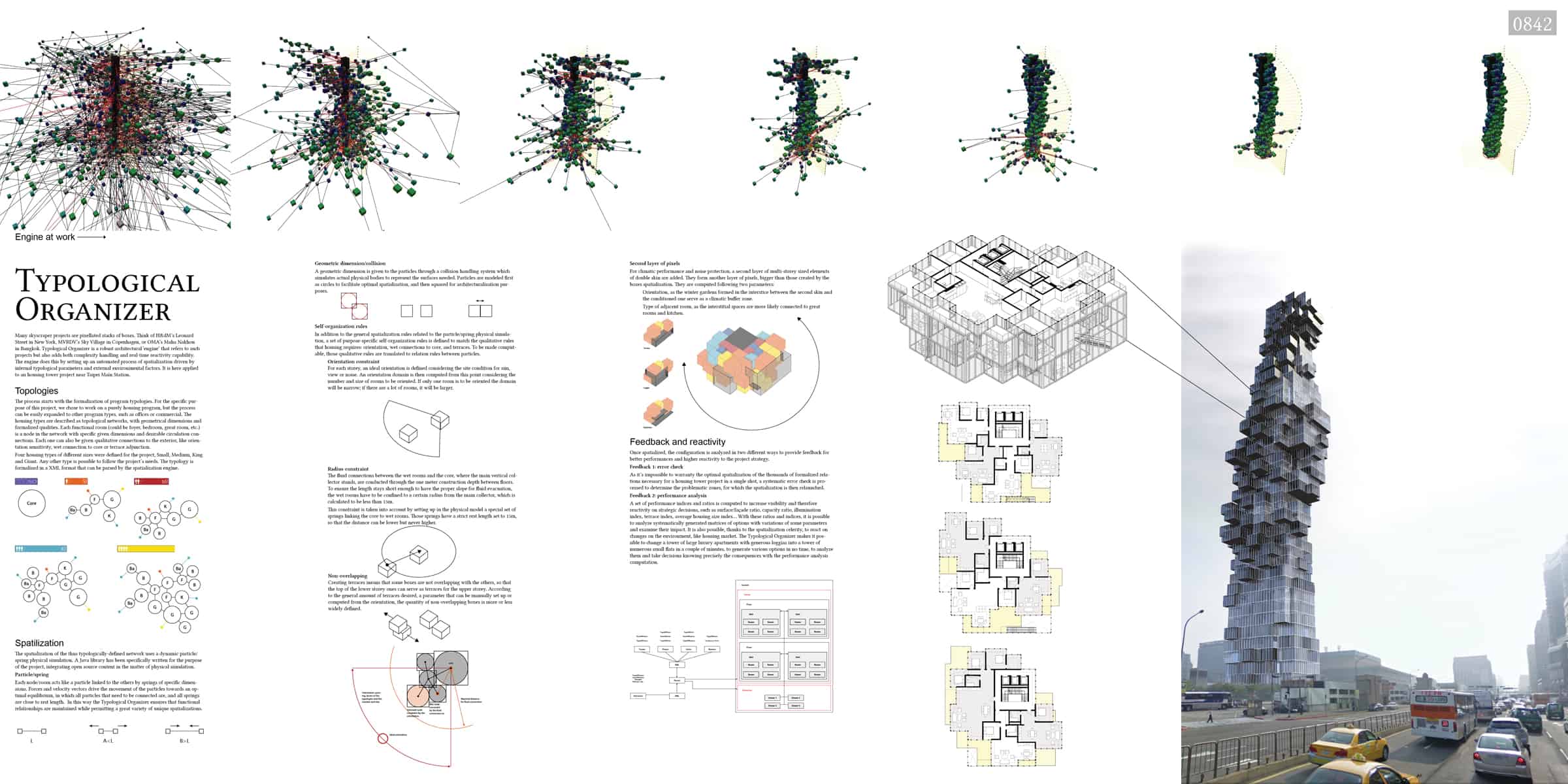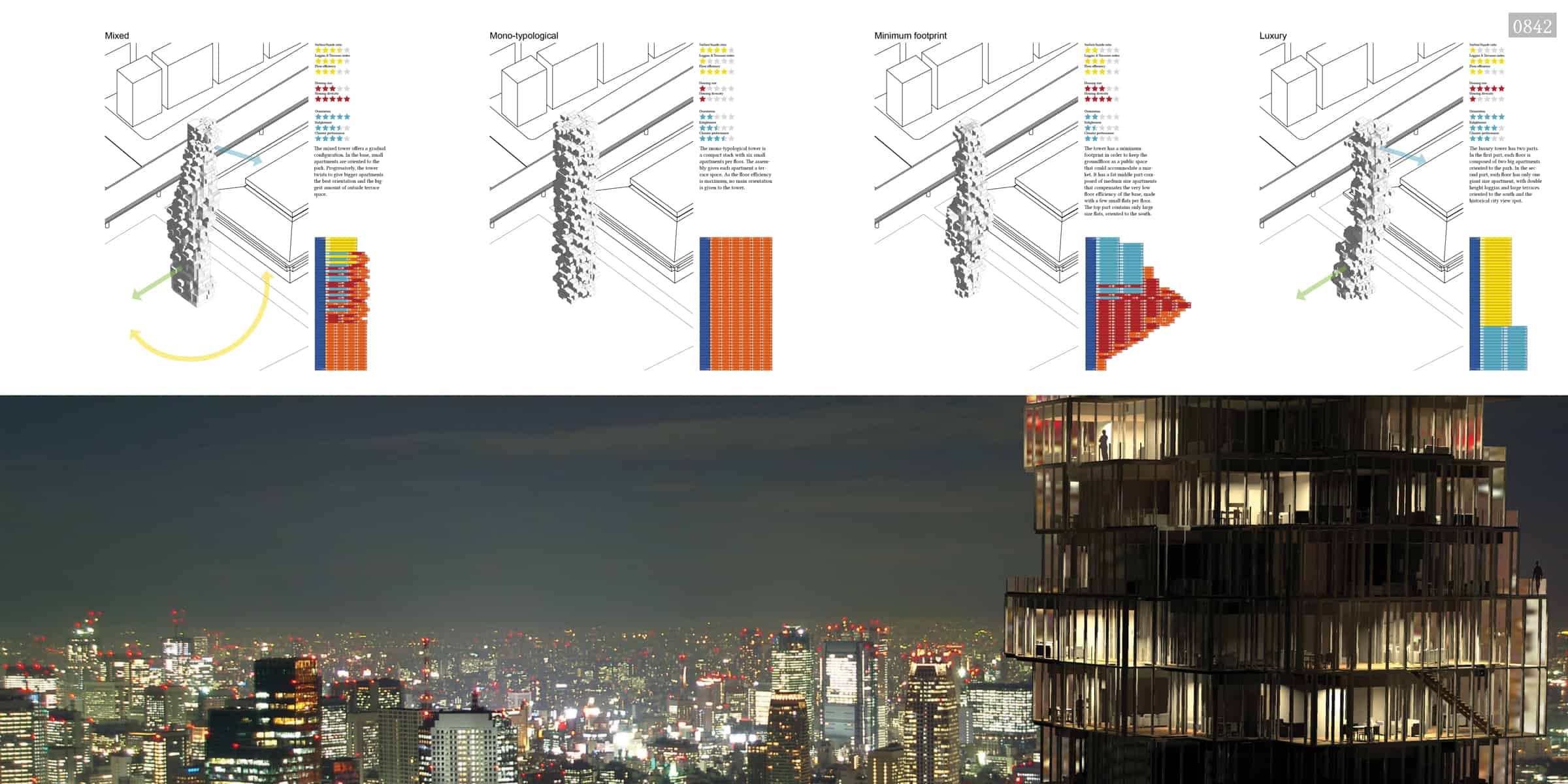Special Mention
2010 Skyscraper Competition
Thomas Favre-Bulle, Mathieu Hefti, Simon Potier
Switzerland

An interactive engine for the design of reactive architecture.
Many skyscraper projects are pixelated stacks of boxes. Typological Organizer is a robust architectural ‘engine’ that refers to such projects but also adds both complexity handling and real-time reactivity capability. The engine does this by setting up an automated process of spatialization driven by internal typological parameters and external environmental factors.
Topologies
For the specific purpose of this project, we chose to work on a purely housing program, but the process can be easily expanded to other program types, such as offices or commercial. The housing types are described as topological networks, with geometrical dimensions and formalized qualities. Each functional room (could be foyer, bedroom, great room, etc.) is a node in the network with specific given dimensions and desirable circulation connections. Each one can also be given qualitative connections to the exterior, like orientation sensitivity, wet connection to core or terrace adjunction.
Spatialization
The spatialization of the thus typologically-defined network uses a dynamic particle/spring physical simulation. A Java library has been specifically written for the purpose of the project, integrating open source content in the matter of physical simulation.
Each node/room acts like a particle linked to the others by springs of specific dimensions. Forces and velocity vectors drive the movement of the particles towards an optimal equilibrium, in which all particles that need to be connected are, and all springs are close to rest length. In this way the Typological Organizer ensures that functional relationships are maintained while permitting a great variety of unique spatializations.
A geometric dimension is given to the particles through a collision handling system which simulates actual physical bodies to represent the surfaces needed. Particles are modeled first as circles to facilitate optimal spatialization, and then squared for architecturalization purposes.
Self-organization rules
In addition to the general spatialization rules related to the particle/spring physical simulation, a set of purpose-specific self-organization rules is defined to match the qualitative rules that housing requires: orientation (angle domain constraint), wet connections to core (radius constraint), and terraces (non-overlapping constraint).
Second layer of ‘pixels’
For climatic performance and noise protection, a second layer of multi-storey sized elements of double skin are added. They form another layer of pixels, bigger than those created by the boxes spatialization. They are computed following orientation and adjacent room type parameters:
Feedback and reactivity
Once spatialized, the configuration is analyzed in two different ways to provide feedback for better performances and higher reactivity to the project strategy.
Feedback 1: error check
As it’s impossible to warranty the optimal spatialization of the thousands of formalized relations necessary for a housing tower project in a single shot, a systematic error check is processed to determine the problematic zones, for which the spatialization is then relaunched.
Feedback 2: performance analysis
A set of performance indices and ratios is computed to increase visibility and therefore reactivity on strategic decisions, such as surface/façade ratio, capacity ratio, illumination index, terrace index, average housing size index… With these ratios and indices, it is possible to analyze systematically generated matrices of options with variations of some parameters and examine their impact. It is also possible, thanks to the spatialization celerity, to react on changes on the environment, like housing market. The Typological Organizer makes it possible to change a tower of large luxury apartments with generous loggias into a tower of numerous small flats in a couple of minutes, to generate various options in no time, to analyze them and take decisions knowing precisely the consequences with the performance analysis computation.


This work is licensed under a Creative Commons License permitting non-commercial sharing with attribution. https://creativecommons.org/licenses/by-nc-nd/4.0/



